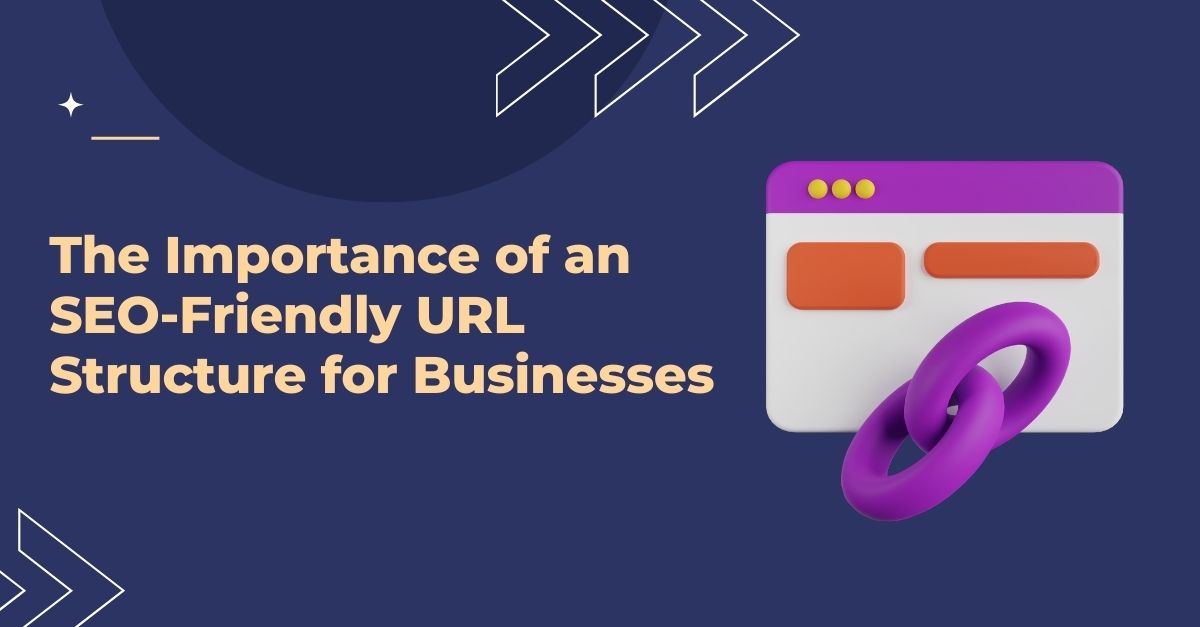The Importance of an SEO-Friendly URL Structure for Businesses5 min read
- dhiraj
- 21/07/2023
- Web Designing
- 0 Comments

In today’s digital age, having a solid online presence is crucial for the success of any business. With millions of websites vying for attention, businesses must employ effective strategies to stand out. One of the most vital elements of a successful online strategy is Search Engine Optimization (SEO). Among various SEO factors, the URL structure of a website plays a pivotal role in determining its search rankings and overall visibility. In this article, we’ll delve into the significance of an SEO-friendly URL structure for businesses and explore the best practices to optimize URLs for search engines.
What is an SEO-Friendly URL?
Before we dive into the benefits of SEO-friendly URLs, let’s understand what they are. An SEO-friendly URL is a web address crafted to be easily understandable by users and search engine crawlers. It incorporates relevant keywords, eliminates unnecessary parameters, and follows a logical structure that reflects the website’s content. Unlike non-SEO-friendly URLs, which often contain random strings of characters or irrelevant information, SEO-friendly URLs are concise, descriptive, and user-friendly.
The Impact of SEO-Friendly URLs on Search Rankings:
Search engines, like Google, use complex algorithms to determine the relevance and quality of websites. URL structure is one of the factors that search engines consider when ranking web pages. Websites with SEO-friendly URLs have a higher chance of ranking well in search results than those with poorly structured URLs. Additionally, SEO-friendly URLs improve user experience, leading to higher click-through rates (CTR), and contribute to better crawlability and indexability, ultimately enhancing a website’s overall search engine visibility.
Creating an SEO-Friendly URL Structure:
Crafting an SEO-friendly URL involves several key considerations. Firstly, keeping the URL length concise is essential while still conveying the page’s content. Short URLs are more user-friendly and easier to share. Secondly, incorporating relevant keywords in the URL helps search engines better understand the page context, boosting rankings. Using hyphens to separate words is preferred, as it enhances readability. Conversely, underscores should be avoided, as they can create ambiguity for search engines.
Hierarchy and Organization in URLs:
A well-organized URL structure not only aids search engine crawlers but also helps users navigate a website more effectively. Hierarchical structures with categories and subcategories in URLs make categorizing and accessing content more accessible. This organization is akin to chapters and subchapters in a book, providing a logical flow of information that users appreciate.
Static vs Dynamic URLs: Which is Better?
Static and dynamic URLs are the two primary web addresses used on websites. Static URLs remain unchanged and are more favourable from an SEO standpoint, as they are easy to index and rank. On the other hand, dynamic URLs are generated by web servers and may contain parameters and session IDs, which can be less user-friendly and more challenging for search engines to interpret. However, by following best practices and ensuring dynamic URLs are well-structured, they can still be SEO-friendly.
Avoiding Common URL Mistakes:
In creating SEO-friendly URLs, it’s essential to avoid common mistakes. Generic and meaningless URLs, such as those with random strings of characters or generic product IDs, offer no context to users or search engines. Additionally, duplicate content issues can arise if multiple URLs lead to the same content, diluting search rankings. Handling URL parameters and session IDs ensures search engines crawl and index the correct pages.
Mobile-Friendly URLs:
With the increasing use of mobile devices, mobile-friendly URLs have become necessary. Responsive design, where the same URL serves content for all devices, is highly recommended, as it simplifies website management and improves user experience. Alternatively, dynamic serving or using separate URLs for mobile versions can be employed, but they require careful implementation to maintain SEO benefits.
URL Redirects and their SEO Implications:
URL redirects are used when a page’s URL changes or when content is moved to a new location. Redirects inform search engines that the page has moved and preserve link equity, preventing broken links. Implementing the appropriate redirect (such as 301 or 302) is crucial, as using the wrong type can negatively affect search rankings.
User Engagement and Shareability:
Believe it or not, the structure of your URLs can impact user engagement. Clean and descriptive URLs are likelier to be clicked on and shared on social media platforms. They act as a sneak peek of what users can expect from the page, enticing them to click and explore further. By using engaging URLs, businesses can increase their chances of attracting organic traffic and expanding their online reach.
Measuring URL Performance:
It’s essential to analyze relevant metrics to understand how well your structure is performing. Google Analytics provides valuable insights into user behaviour, including page views, bounce, and conversion rates. By tracking these metrics for different URLs, businesses can identify strengths and weaknesses in their URL strategy and make data-driven improvements.
SEO-Friendly URLs in E-Commerce:
For e-commerce businesses, optimizing URLs is even more critical. Including unique product identifiers in URLs can improve search visibility and help users find specific products easily. Moreover, handling product variations and filters in URLs ensures that customers can navigate and compare different options efficiently, resulting in a seamless shopping experience.
International SEO and Multilingual URLs:
Global businesses need to consider international SEO and multilingual URL structuring. Creating separate URLs for different languages or using hreflang tags helps search engines display the appropriate version of a page to users based on their language and location. However, managing multilingual URLs requires careful planning and implementation to avoid duplicate content issues and other SEO challenges.
Future-proofing Your URL Strategy:
The world of SEO is constantly evolving, with search engines updating their algorithms regularly. To stay ahead of the curve, businesses must continuously adapt and optimize their URL strategies. Preparing for emerging technologies, such as voice search and AI, and embracing new trends ensures that a website’s URL structure remains relevant and effective in the future.
Conclusion:
In conclusion, an SEO-friendly URL structure is a vital element in the success of any online business. It not only improves search rankings but also enhances user experience and engagement. By following best practices and optimizing URLs for search engines, businesses can increase their online visibility, attract organic traffic, and stay ahead in the competitive digital landscape.





